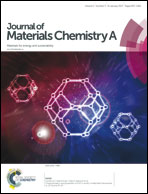Design of La2−xPrxNiO4+δ SOFC cathodes: a compromise between electrochemical performance and thermodynamic stability†
Abstract
Architecturally designed La2−xPrxNiO4+δ (with x = 0, 0.5, 1 and 2) cathodes on the Ce0.9Gd0.1O2−δ (CGO) electrolyte have been prepared with a view to take advantage of the complimentary properties of the two extreme compositions La2NiO4+δ and Pr2NiO4+δ, i.e. the superior stability of La2NiO4+δ and the higher electronic conductivity of Pr2NiO4+δ. The design consists of stacking of two layers starting with a 3D tree-like microstructure (∼20 μm thick) over a thin dense base layer (∼100 nm) fabricated in one step by electrostatic spray deposition (ESD) and then topped by using a screen-printed (SP) current collecting layer of the same composition. X-ray diffraction confirms the formation of a complete solid solution crystallizing in a single phase orthorhombic structure with the Fmmm space group. The thermodynamic stability and polarisation resistance (Rpol) decrease by increasing the Pr content. Among the complete La2−xPrxNiO4+δ solid solutions, LaPrNiO4+δ shows the best compromise between electrochemical properties (the lowest Rpol value available in the literature for this composition, 0.12 Ω cm2 at 600 °C) and thermodynamic stability in air. Moreover, an anode supported single cell (Ni-3YSZ/Ni-8YSZ/8YSZ/CGO) including the LaPrNiO4+δ double layer electrode shows a maximum power density of 438 mW cm−2 at 700 °C.



 Please wait while we load your content...
Please wait while we load your content...